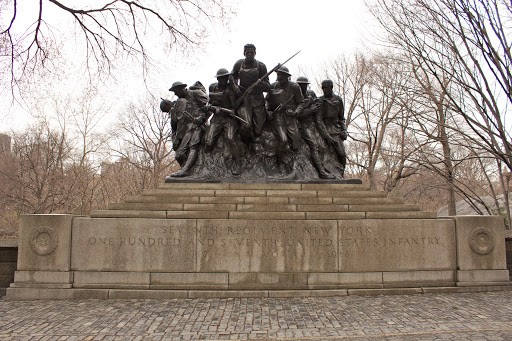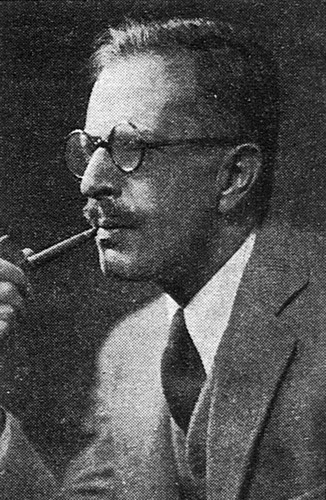107th Infantry Memorial
Introduction
Text-to-speech Audio
Images
107th Infantry Memorial

Karl Illava in the 1930s

A close up of the monument
Backstory and Context
Text-to-speech Audio
As the United States mobilized for the Great War (now referred to as World War I), the Seventh New York Infantry, a unit which traced its origins back hundreds of years to the American Revolution, officially became the 107th Infantry Regiment and was placed in the Fifty-Fourth Brigade, Twenty-Seventh Division. The regiment drilled in the Sheep Meadow, not far from where its monument stands today, before shipping out to Europe and the Western Front with 2,995 officers and men in May 1918. Between September 24 and October 21 of that same year, the 107th Infantry, with the rest of the Twenty-Seventh Division, took part in the Allied Somme Offensive, which successfully broke Germany’s defensive Hindenburg Line and helped bring an end to the war. The 107th Infantry saw heavy fighting during the assault, including brutal hand-to-hand combat. By late March 1919, the entire regiment had returned home from Europe. During its service on the Western Front, the 107th Infantry suffered 1,918 casualties. Of the casualties, 437 were killed in action, 1,383 were wounded, and another ninety-eight later succumbed to their wounds.
One of the men of the 107th Infantry was Karl Illava (1896-1954). The son of a successful New York City starch manufacturer, Illava served as a dispatch rider during the war and rose to the rank of sergeant major. Before the war, he was a sculptor and spent three years studying under Gutzon Borglum, the man who would later create the Mount Rushmore National Memorial. After the war, Illava returned to New York City and resumed his artistic career. At some point, the Seventh Regiment New York 107th United Infantry Memorial Committee commissioned Illava to sculpt a memorial to commemorate the regiment’s service in the Great War. Taking inspiration from his own experience in the conflict, he went to work at his studio in Elmsford in Westchester County. Unbeknownst to Illava at the time, the memorial to the 107th Infantry would become his most famous work.
On September 27, 1927, the ninth anniversary of the regiment’s breaking through the Hindenburg Line at St. Quentin Canal, the monument was revealed to a crowd of a few thousand people and honored guests. Perched on a stepped granite pedestal designed by New York architects Rogers and Haneman, the bronze sculpture, cast in Italy, depicts seven anonymous larger-than-life-sized soldiers of the 107th Infantry in action. Three of the men, with courageous and determined expressions on their faces, appear to advance forward with rifles in hand and bayonets fixed. Two others help two wounded comrades, one with a dressing wrapped around his head and the other completely limp and barely alive. Rather than glorify or romanticize war, Illava’s work portrays it as brutal, chaotic, and deadly, while still commemorating the bravery and sacrifices of the men of the 107th Infantry during the Great War.
The monument to the 107th Infantry remained in the location at which it was dedicated until the 1950s. In 1954, the City of New York moved the monument to its current location, where East Sixty-Seventh Street meets Fifth Avenue. Originally, the monument was closer to where Sixty-Fifth Street meets Fifth Avenue, but it was relocated about a block north to make way for a new east-west road into Central Park.
Cite This Entry
Thagard, Gavin, Martin Donavon, and Francis Curran. "107th Infantry Memorial." Clio: Your Guide to History. October 14, 2020. Accessed March 17, 2025. https://theclio.com/tour/463/19
Sources
"107th Infantry Regiment World War I." New York State Military Museum and Veterans Research Center. New York State Division of Military and Naval Affairs. 3 April 2017. Web. 13 October 2020 <https://dmna.ny.gov/historic/reghist/wwi/infantry/107thInf/107thInfMain.htm>.
Durante, Diane. Outdoor Monuments of Manhattan. New York: New York University Press, 2007.
Fitzpatrick, Kevin C. World War I New York: A Guide to the City's Enduring Ties to the Great War. Guilford, CT: Globe Pequot, 2017.
"One Hundred Seventh Infantry Memorial." New York City Department of Parks and Recreation. The City of New York. Web. 13 October 2020 <https://www.nycgovparks.org/parks/central-park/monuments/1136>.
Raftery, Patrick. "Memorializing the 'Splendid Little War' in Port Chester." Best of the Historian. Westchester County Historical Society. 2017. Web. 13 October 2020 <https://westchesterhistory.com/library/best-of-the-historian/>.
Snyder, Cal. Out of Fire and Valor: The War Memorials of New York City from the Revolution to 9-11. Piermont, NH: Bunker Hill Publishing Inc., 2005.
Wingate, Jennifer. Sculpting Doughboys: Memory, Gender, and Taste in America's World War I Memorials. Burlington, VT: Ashgate, 2013.
http://ctmonuments.net/2011/04/107th-regiment-monument-new-york-ny/
https://westchesterhistory.com/library/best-of-the-historian/
https://diannedurantewriter.com/archives/1613

